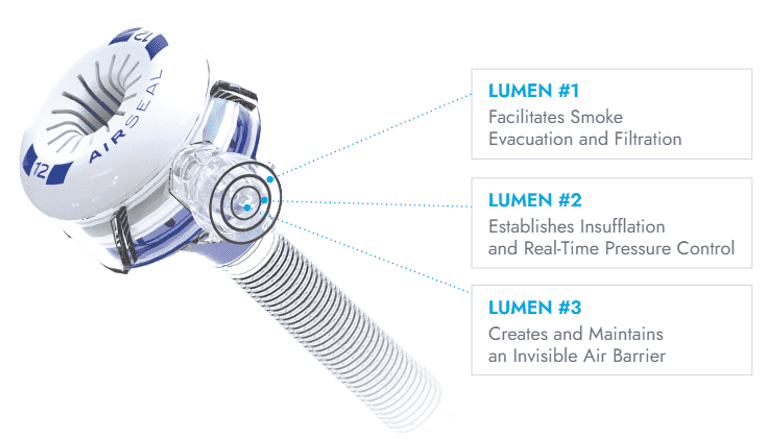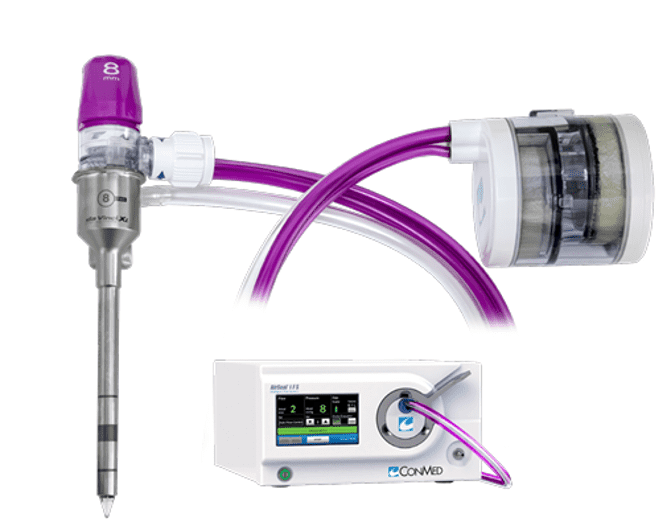AirSeal® iFS
Intelligent Flow System
Intelligent Flow System
AirSeal® is the ONLY insufflator backed by clinical data.
36 peer-reviewed studies across five specialties demonstrated that AirSeal®:
What Sets AirSeal® Apart
Pressure precision with AirSeal® enables you to perform surgery at low pressure with confidence, knowing you will maintain your working space. Unlike conventional high-flow insufflation, AirSeal® maintains a stable pneumoperitoneum even with large leaks and heavy suction.1,2
How AirSeal® Helps You Intraoperatively
AirSeal® provides uninterrupted visibility and clear operative fields through stable pneumoperitoneum and constant smoke evacuation, enabling you to operate efficiently at low pressure.1,2
How AirSeal® Works Differently
A proprietary cannula design creates a responsive gas barrier, ensuring CO2 flow and pressure consistency. This enables precision at low pressure without compromising surgical exposure.
Published data also shows that laparoscopic surgery with AirSeal® at low pressure, versus standard insufflation, improved postoperative pain scores.5-12
“After hundreds of cases and a significant amount of data collected in our research studies, I was confident that the AirSeal® System would become the new standard of care. I will not operate without it.”


Jaime Landman, MD
Professor of Urology and Radiology Chairman, Department of Urology University of California
AirSeal®’s proprietary cannula design ensures uninterrupted CO2 flow and simultaneous smoke evacuation to create a responsive gas barrier that maintains a stable pneumoperitoneum. This is different from devices that attempt to deliver multiple functions through the same lumen.

CONMED and Intuitive Surgical's collaboration brings you the AirSeal® Robotic Solution. This enables seamless integration with the da Vinci X and XI systems* - without the need for an assist port.

“I can’t emphasize enough how much AirSeal® has helped both myself and my patients. I believe in AirSeal® because it improves my patients’ outcomes and maintains my surgical exposure… even in smokey cases and when I have a high BMI patient.”


Eben Strobos, MD, FACS, FASCRS






















| CAT # | AS-IFS1 |
| Voltage | 120V |
| CAT # | IFS-WC1 |
| Note | USA/Domestic Use Only |
| CAT # | IFS-WC2 |
| Note | International Use Only |
| CAT # | IFS-BC1 |
| Note | Required Connector for Bottled Gas Use |
| Note | USA and International Use |
| AS-ICART | AS-ICART |
| Note | Cart with Bottle Rack, Holds Two “E” Size C02 Tanks |
| CAT # | AS-ICART-V |
| Note | Holds Two Two “E” Size C02 Tanks, and Switching Valve |
| CAT # | IAS5-100LP |
| Length | 100mm |
| Qty | 6/Box |
| CAT # | IAS5-120LP |
| Length | 120mm |
| Qty | 6/Box |
| CAT # | IASB5-150 |
| Length | 150mm |
| Note | (for use with single site surgical platforms) |
| Qty | 6/Box |
| CAT # | IAS8-100LP |
| Length | 100mm |
| Qty | 6/Box |
| CAT # | IAS8-120LP |
| Length | 120mm |
| Qty | 6/Box |
| CAT # | IASB12-100 |
| Length | 100mm |
| Qty | 6/Box |
| CAT # | IASB12-120 |
| Length | 120mm |
| Qty | 6/Box |
| CAT# | IAS12-150 |
| Length | 150mm |
| Qty | 6/Box |
| CAT # | IAS12-100LPI |
| Length | 100mm |
| Qty | 6/Box |
| CAT # | IAS12-120LPI |
| Length | 120mm |
| Qty | 6/Box |
| CAT # | ASM-EVAC1 |
| Qty | 6/box |
| CAT # | ASM-EVAC1-BI |
| Purchasing Unit of Measure | 6/Box |
1 Bucur P, Hofmann M, Menhadji A, et al. Comparison of Pneumoperitoneum Stability Between a Valveless Trocar System and Conventional Insufflation: A Prospective Randomized Trial. Urology. 2016;94:274280. doi:10.1016/j.urology.2016.04.022
2 Nepple KG, Kallogjeri D, Bhayani SB. Benchtop evaluation of pressure barrier insufflator and standard insufflator systems. SurgEndosc. 2013 Jan;27(1):333-8. doi: 10.1007/s00464-012-2434-x. Epub 2012 Jul 26. PMID: 22833262
3 Sroussi J, Elies A, Rigouzzo A, et al. Low pressure gynecological laparoscopy (7mmHg) with AirSeal® System versus a standard insufflation (15mmHg): A pilot study in 60 patients. J Gynecol Obstet Hum Reprod. 2017;46(2):155-158. doi:10.1016/j.jogoh.2016.09.003
4 Covotta M, Claroni C, Torregiani G, et al. A Prospective, Randomized, Clinical Trial on the Effects of a Valveless Trocar on Respiratory Mechanics During Robotic Radical Cystectomy: A Pilot Study. Anesth Analg. 2017;124(6):1794-1801. doi:10.1213/ANE.0000000000002027
5 Saway JP, McCaul M, Mulekar MS, McMahon DP, Richards WO. Review of Outcomes of Low Verses Standard Pressure Pneumoperitoneum in Laparoscopic Surgery. Am Surg. 2022;88(8):1832-1837. doi:10.1177/00031348221084956
6 Celarier S, Monziols S, Célérier B, et al. Low-pressure versus standard pressure laparoscopic colorectal surgery (PAROS trial): a phase III randomized controlled trial. Br J Surg. 2021;108(8):998-1005. doi:10.1093/bjs/znab069
7 Ferroni MC, Abaza R. Feasibility of robot-assisted prostatectomy performed at ultra-low pneumoperitoneum pressure of 6 mmHg and comparison of clinical outcomes vs standard pressure of 15 mmHg. BJU Int. 2019 Aug;124(2):308-313. doi: 10.1111/bju.14682. Epub 2019 Feb 7. PMID: 30653808
8 Ramshaw B, Forman B, Heidel E, Dean J, Gamenthaler A, Fabian M. A Clinical Quality Improvement (CQI) Project to Improve Pain After Laparoscopic Ventral Hernia Repair. Surg Technol Int. 2016;29:125-130
9 Ramshaw B, Vetrano V, Jagadish M, Forman B, Heidel E, Mancini M. Laparoscopic approach for the treatment of chronic groin pain after inguinal hernia repair : Laparoscopic approach for inguinodynia. Surg Endosc. 2017;31(12):5267-5274. doi:10.1007/s00464-017-5600-3
10 Foley CE, Ryan E, Huang JQ. Less is more: clinical impact of decreasing pneumoperitoneum pressures during robotic surgery. J Robot Surg. 2021;15(2):299-307. doi:10.1007/s11701-020-01104-4
11 Abaza R, Martinez O, Ferroni MC, Bsatee A, Gerhard RS. Same Day Discharge after Robotic Radical Prostatectomy. J Urol. 2019;202(5):959-963. doi:10.1097/JU.0000000000000353
12 Buda A, Di Martino G, Borghese M, et al. Low-Pressure Laparoscopy Using the AirSeal System versus Standard Insufflation in Early-Stage Endometrial Cancer: A Multicenter, Retrospective Study (ARIEL Study). Healthcare (Basel). 2022;10(3):531. Published 2022 Mar 14. doi:10.3390/healthcare10030531
13 Annino, F., Topazio, L., Autieri, D., Verdacchi, T., De Angelis, M., & Asimakopoulos, A. D. (2017). Robotic partial nephrectomy performed with Airseal versus a standard CO2 pressure pneumoperitoneum insufflator: a prospective comparative study. Surgical endoscopy, 31(4), 1583–1590. https://doi.org/10.1007/s00464-016-5144-y
14 Shahait, M., Cockrell, R., Yezdani, M., Yu, S. J., Lee, A., McWilliams, K., & Lee, D. I. (2019). Improved Outcomes Utilizing a Valveless-Trocar System during Robot-assisted Radical Prostatectomy (RARP). JSLS: Journal of the Society of Laparoendoscopic Surgeons, 23(1), e2018.00085. https://doi.org/10.4293/JSLS.2018.00085
15 Paull JO, Parsacandola SA, Graham A, Hota S, Pudalov N, Obias V. The impact of the AirSeal® valve-less trocar system in robotic colorectal surgery: a single-surgeon retrospective review. J Robot Surg. 2021;15(1):87-92. doi:10.1007/s11701-020-01071-w
16 Desroches B, Porter J, Bhayani S, Figenshau R, Liu PY, Stifelman M. Comparison of the Safety and Efficacy of Valveless and Standard Insufflation During Robotic Partial Nephrectomy: A Prospective, Randomized, Multi-institutional Trial. Urology. 2021 Jul;153:185-191. doi: 10.1016/j.urology.2021.01.047. Epub 2021 Feb 10. PMID: 33577899.